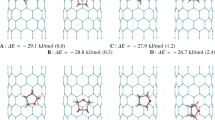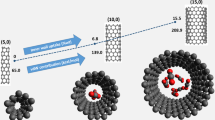Abstract
A comparative analysis of interaction potentials, classified according to the parametrization method, namely Lorentz-Berthelot rules, semi-empirical or ab initio calculations, found their energy depths to scale, respectively, to ca 30K, ca 40K, and ca 60K. We draw the Potential Energy Surfaces (PESs) for a hydrogen probe molecule inside a Carbon Nano-Tube (CNT): it is shown that the adsorption energy increases with the hard radius of the interaction potential and decreases as the CNT pore enlarges. This is valid just for low-medium pressures, when hydrogen repulsions are negligible. If not, adsorption is driven by H 2– H 2 hard radius despite all other parameters. Monte Carlo (MC) simulations, following the Gibbs Ensemble (GE) in high density conditions, confirm that the thermodynamic equilibrium of an order-disorder phase transition show no changes throughout any of the studied potentials. We also analyse, in the Grand Canonical (GC) ensemble, the geometric and structural characteristics of square lattice bundles of Single Walled Nano Tubes (SWNTs) with regard to their influence on adsorption storage. To do so, we develop a method for independently simulate inner or outer adsorption in infinitely long nanotube lattice systems. Our results suggest a pressure range for convenient H 2 storage and enlighten the influence of CNT size on adsorption performance. In addition, larger CNTs are capable to host further hydrogen layers, but only at very high pressures.

Each SWNT has shown a different pressure range for convenient adsorptive storage, strongly affected by the type of potential employed.






Similar content being viewed by others
References
Froudakixs, G E (2011). Mater Today, 14(7–8), 324–328.
Iijima, S (1991). Nature, 354(6348), 56–58.
Dillon, A C, Jones, K M, Bekkedahl, T A, Kiang, C H, Bethune, D S, Heben, M J (1997). Nature, 386(6623), 377–379.
Karatepe, N, & Yuca, N (2011). Int J Hydrog Energy, 36(17), 11,467–11,473.
Liu, C, & Cheng, H M (2005). J Phys D-Appl Phys, 38(14), R231–R252.
Ioannatos, G E, & Verykios, X E (2010). Int J Hydrog Energy, 35(2), 622–628.
Konstantakou, A, Steriotis, T A, Papadopoulos, G K, Kainourgiakis, M, Kikkinides, E S, Stubos, A K (2007). Appl Surf Sci, 253(13), 5715–5720.
Nguyen, T X, Bae, J S, Wang, Y, Bhatia, S K (2009). Langmuir, 25(8), 4314–4319.
Silvera, I F, & Goldman, V V (1978). J Chem Phys, 69(9), 4209–4213.
Buch, V (1994). J Chem Phys, 100(10), 7610–7629.
Steele, WA (1974). The Interaction of Gases with Solid Surfaces.
Wang, S C, Senbetu, L, Woo, C W (1980). J Low Temp Phys, 41(5–6), 611–628.
Frankland, S J V, & Brenner, D W (2001). Chem Phys Lett, 334(1–3), 18–23.
Ferre-Vilaplana, A (2005). J Chem Phys, 122(21), 7.
Dubbeldam, D, Calero, S, Vlugt, TJH, Krishna, R, Maesen, TLM, Beerdsen, E, Smit, B (2004). Physical Review Letters, 93(8).
Norman, G E, & Filinov, V S (1969). High Temp, 7(2), 216–222.
Panagiotopoulos, A Z, Quirke, N, Stapleton, M, Tildesley, D J (1988). Mol Phys, 63(4), 527–545.
Metropolis, N, Rosenbluth, A W, Rosenbluth, M N, Teller, A H, Teller, E (1953). J Chem Phys, 21(6), 1087–1092.
Martin, M G (2012). Mcccs towhee version 7, 0, 4. http://towhee.sourceforge.net.
Sun, D Y, Liu, J W, Gong, X G, Liu, Z F (2007). Phys Rev B, 75(7), 7.
Darkrim, F, & Levesque, D (2000). J Phys Chem B, 104(29), 6773–6776.
Patchkovskii, S, Tse, J S, Yurchenko, S N, Zhechkov, L, Heine, T, Seifert, G (2005). Proc Natl Acad Sci USA, 102(30), 10,439–10,444.
Cracknell, R F (2001). Phys Chem Chem Phys, 3(11), 2091–2097.
Feynman, RP, & Hibbs, AR (1965). Quantum Mechanics and Path Integrals. New York.
Rappe, A K, Casewit, C J, Colwell, K S, Goddard, W A, Skiff, W M (1992). J Amer Chem Soc, 114(25), 10,024–10,035.
Snurr, R Q, Bell, A T, Theodorou, D N (1993). J Phys Chem, 97(51), 13,742–13,752.
Chen, B, & Siepmann, J I (2001). J Phys Chem B, 105(45), 11,275–11,282.
Chen, B, & Siepmann, J I (2000). J Phys Chem B, 104(36), 8725–8734.
Acknowledgments
This work has been funded by the Fundação para a Ciência e a Tecnologia - FCT, Portugal, through grant SFRH/BD/90502/2012.
Author information
Authors and Affiliations
Corresponding author
Additional information
This paper belongs to Topical Collection 9th European Conference on Computational Chemistry (EuCo-CC9)
Electronic supplementary material
Below is the link to the electronic supplementary material.
Rights and permissions
About this article
Cite this article
Lerario, M., Magalhães, A.L. A study of interaction potentials for H 2 adsorption in Single Walled Nano Tubes: a possible way to more realistic predictions. J Mol Model 20, 2194 (2014). https://doi.org/10.1007/s00894-014-2194-8
Received:
Accepted:
Published:
DOI: https://doi.org/10.1007/s00894-014-2194-8




